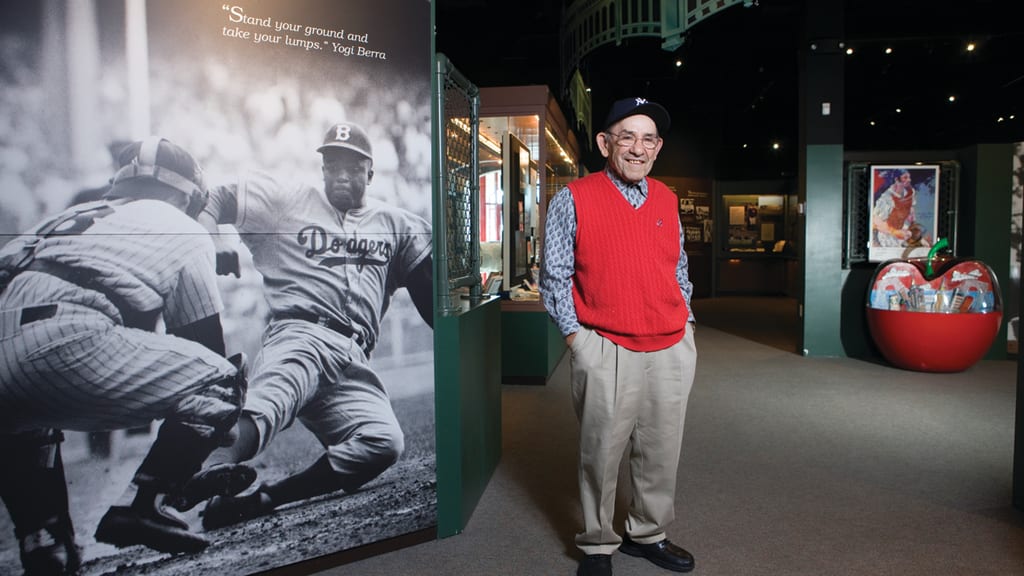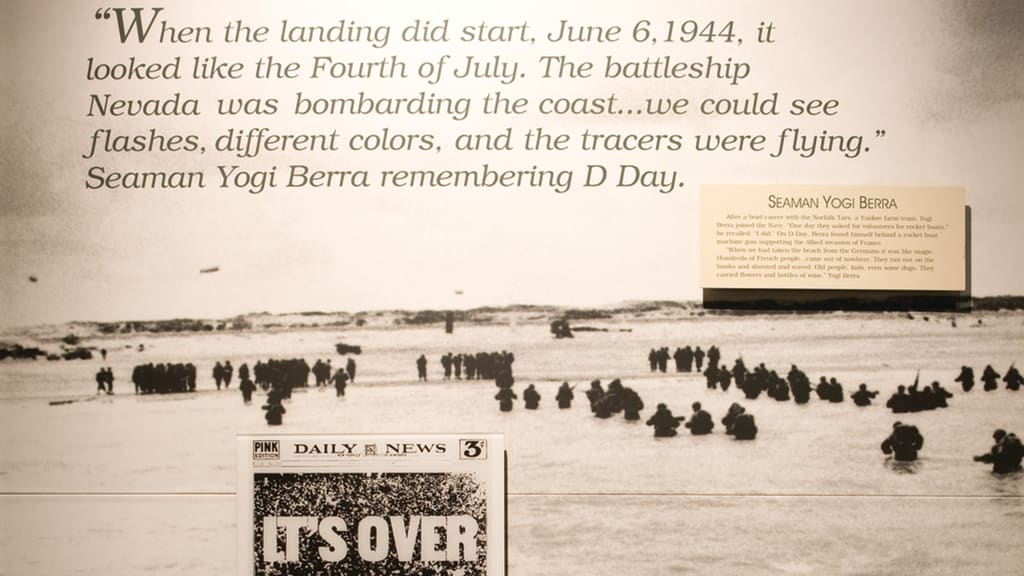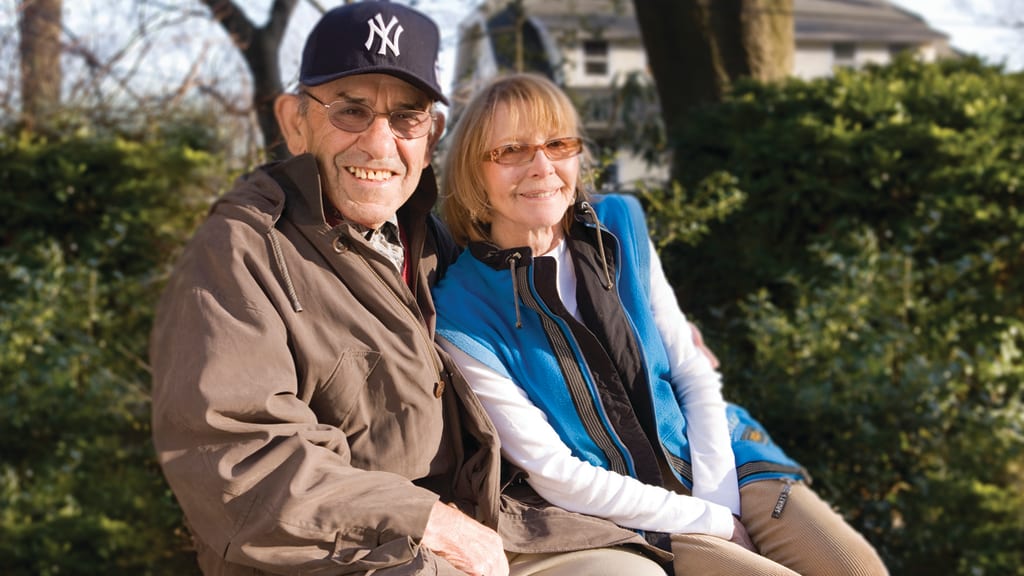
Ed. Note: During the current stoppage in baseball, Yankees Magazine is periodically putting some of its archival material online for the first time. This story first appeared in the April 2009 edition. Get more articles like this delivered to your doorstep by purchasing a subscription to Yankees Magazine at yankees.com/publications.
“The house looks a lot different from the backyard than from the inside.”
That’s what Yogi Berra said as we walked down the steps from his deck to his backyard at the end of an afternoon spent together for this story.
Classic Yogi Berra. Yogi is charming and funny without even trying to be charming and funny.
I don’t remember where I was or what I did on Presidents’ Day in any year of my life except for 2009.
On Presidents’ Day that year, I was lucky enough not to get the day off from work. Instead, my assignment on Feb. 16 was to spend the afternoon with an American icon.
Yankees photographer James Petrozzello and I began our coverage of the 18-year Major League veteran, former Yankees manager and Spring Training instructor at the museum named in his honor.
It was fitting that we began the five-hour journey at the Yogi Berra Museum & Learning Center on the campus of Montclair State University in New Jersey, because the shrine is a major part of the 83-year-old’s life today.
“Yogi is very humbled to have a museum that celebrates his life,” said Dave Kaplan, who is the director of the museum and learning center. “He feels very fortunate, and he tells everyone that people usually have museums built in their honor after they pass away.
“The greatest thing about the museum is that it appeals to several different generations,” Kaplan continued. “Young kids know Yogi from the Aflac commercials in the barber’s chair, and there are people in their 50s and 60s who remember Yogi as a great Yankee.”
Kaplan also shed light on the past, present and future of the museum.
“The former CEO of Kmart, Floyd Hall, built a Minor League stadium on the campus of Montclair State University after he founded the New Jersey Jackals of the independent league,” Kaplan explained. “He was a good friend of Yogi, and he asked Yogi if he could name the stadium after him. Yogi said, ‘Sure, whatever you want.’ After the stadium was built, a few people suggested that they build a gallery next to it so that fans could learn more about Yogi. The plans developed into the creation of the museum in 1997, and it opened in December 1998.
“We have 7,200 square feet now, and that will increase,” Kaplan continued. “We are undergoing a renovation that includes additional exhibit space and a new exterior.”
Besides housing more than 100 artifacts from Yogi’s life, the museum has thrived in recent years.

“We run four or five different programs that include book signings, seminars for parents of student athletes and school field trips each month,” Kaplan said. “We also run a camp for about 35 kids every year in the first week of August.
“Additionally, we just formed a partnership with the Cal Ripken, Sr. Foundation,” Kaplan continued. “The camps that we run with the Ripken foundation expose underprivileged children to baseball. We reach out to children in underserved urban areas. We held three camps with the Ripken foundation last year, and we will be holding several more this summer. Because of our alliance with the Ripken foundation, those camps are free.”
After my conversation with Kaplan, I met with two of Yogi’s three sons in their offices, which are located in the museum. Yogi’s oldest son, Larry, 59, runs his own commercial flooring business and was not at the museum when I was there.
Initially, I asked Dale Berra, 52, who played in the Majors for 11 years, including two with the Yankees, what his father’s most endearing quality is.
“When we were growing up, if we went to the movies and the manager said, ‘C’mon Yogi, we will get you in the side door,’ my dad would say, ‘No, we will wait back here with everyone else,’” Dale said. “That’s the way he is. He distinguishes no difference between the guy who sells him his bagel in the morning and the Wall Street CEOs he’s known. He knows the difference, but he doesn’t care.
“You won’t meet a superstar athlete who is more down to earth,” Dale continued.
I then turned my attention to Tim Berra, 57, who -- along with Dale -- manages his father’s business affairs as part of LTD Enterprises, Inc.
I asked Tim to talk about Yogi Berra the dad. I wanted to know what Yogi is like away from the baseball scene.
“He is the best father in the world,” Tim said. “He never put pressure on us to play baseball or to do anything else for that matter. He taught us to just go out and enjoy what we were doing.”
As Tim concluded his thought, the office door swung open.
And as if he had been part of the entire conversation, Yogi skipped over any kind of greeting and instead asked …
“Enjoy what?”
Tim began to laugh as he responded to his father’s question.
“None of your business.”
As Yogi unbuttoned his forest green winter jacket, he looked at me and said, “Don’t believe anything they say.”
The humorous moment was a perfect segue for the afternoon. Just like at the end of the day, Yogi was charming and funny without even trying to be charming and funny.
After a few more minutes of light-hearted banter with the Berras, Yogi announced that he was ready to escort us through the museum and, in essence, through his life.
We started at a display in the front lobby of the museum that held a baseball signed to the museum by President Obama.
“I signed a baseball this summer and sent it to him,” Yogi said. “He was nice enough to return the favor. That’s nice of him since he’s pretty busy these days.”
As we walked away from the lobby, Yogi shared some other presidential memories.
“I met President Ford, President Reagan and President [George W.] Bush in the White House,” Yogi said. “I played golf with the other President Bush, and I met JFK in Spring Training. They were all nice guys.”
Yogi then guided us toward a photo of Babe Ruth at Yankee Stadium.
“I met Babe Ruth in 1947 in St. Louis,” Yogi said. “I went up and asked him if I could take a picture with him. I was really nervous.”
I was compelled to ask Yogi who the most impressive person he met was.
“I meet impressive people every day,” Yogi said. “Nobody really sticks out above anyone else.”
From there, we walked to a display that featured several photos of Yogi and his brothers and parents from his youth.
“My dad came to America from Italy,” Yogi said. “He landed in New York and took the first train to St. Louis because they had jobs there. He worked in a brickyard his whole life.
“I had three older brothers, and they all could have made it to the Majors, but my dad wanted them to go to work rather than play baseball,” Yogi said. “There was no money in baseball then, but they convinced my dad to let me play because they all were making good money. I signed for $90 a month, and I got a $500 bonus. Playing baseball sure beats working.
“When I finally made it to the big leagues, I told my dad, ‘If you had let all of your sons play ball, you would have been a millionaire.’ He said, ‘Blame your mother.’”
While on the subject of Yogi’s earlier years, we walked to an exhibit on World War II, specifically D-Day, which Yogi fought in as part of his service in the U.S. Navy.
“D-Day was like watching fireworks on the Fourth of July,” he recalled in great detail. “I was on a rocket boat. We had 24 rockets, five machine guns, a twin .50 and three .30s. We stayed about 200 yards off the beach. When our ground soldiers ran into problems, we fired the rockets.

“I never saw so many airplanes in my life,” Yogi continued. “At one point, I was looking over the deck and my officer said, ‘You better stop doing that or you’ll get your [darn] head shot off.’ I was 18 years old at the time, and I didn’t even have time to be scared.”
After serving in the war for three years, Yogi was transferred to a New London, Connecticut, submarine base.
“When I got there, they built a ball field and started the U.S. Navy Submarine team,” Yogi said.
“The submarine team played Major League teams at that time,” Kaplan explained. “And even though Yogi was in the Navy, he was obligated to play for the Yankees when he got out of the service. Mel Ott of the New York Giants saw Yogi play and offered [former Yankees general manager] Larry MacPhail $50,000 for ‘that little kid who was playing catcher.’
“Larry MacPhail had never seen Yogi play before, but he said, ‘If the Giants are offering me $50,000 for him, he must be pretty good.’ MacPhail asked Berra to report to Yankee Stadium. He met with him in his office and asked him to report to the Yankees’ Minor League team in Newark, New Jersey, soon after.”
“The rest is history,” Yogi added.
Part of that history is Yogi’s World Series record 10 titles as a player, which we discussed while peering into a glass case that holds all 10 of those championship rings.
“Sometimes I think players get nervous in big games or with men on base,” said Berra. “I never did. If I saw the ball well, I swung at. It didn’t matter if it was high, low or in the strike zone.
“I don’t think we will ever see a team win five straight championships again, the way we did from 1949 through 1953,” Berra said. “With free agency, players move around so much that teams can’t stay good for that long. But that is the way the game is now. If I was a player today, I would go to the team that offered me the most money.”
I also asked Yogi about some of his teammates from those teams, including his long-time friend Phil Rizzuto.
“I met Phil in Norfolk, Virginia,” Yogi said before offering the first Yogi-ism of the day. “That’s where he got married … to his wife.
“When we would go on a train, we would put lobsters in Phil’s bag because he was afraid of every animal,” Yogi continued.
“Joe DiMaggio never slid for a ball the way outfielders do today,” Yogi said as we walked toward a wall that featured DiMaggio’s original plaque from Yankee Stadium, along with Mickey Mantle’s. “He always made it look easy. He was amazing.”
Our last stop on the museum tour was at one of Yogi’s favorite artifacts.
“This is the glove I caught Don Larsen’s perfect game in. [Longtime Yankees clubhouse manager] Pete Sheehy had it bronzed for me.”
“I still can’t believe that I was part of that game,” Yogi said as he admired the glove. “It never happened in a World Series game. Look at how long this game has been played, and it was the only no-hitter or perfect game in the World Series.”
Although our tour of Yogi’s past was over, the afternoon was still young. The next stop was Yogi’s house, located about five miles from the museum.
The plan was for me to drive with Yogi in his SUV and for Petrozzello to follow us. I admit now that I had second thoughts when we were walking toward Yogi’s car (he confessed to having “very bad” eyesight).
Despite my trepidation, I went along with the plan, and we arrived at Yogi and Carmen Berra’s house safely.
Carmen greeted us in front of the 1898 house, which has a spiral staircase in the front foyer and is filled with an antique collection that spans every corner of every room.
“My wife is an antique buff,” Yogi said as we walked through the front door. “I don’t have too much say in what is in our house.”
As the Berras and I strolled into Yogi’s TV room, which is adorned with leather club seats, family photos and a large print of Yogi and Phil Rizzuto playing golf, Carmen joked with me about the amount of time Yogi spends in the cozy room.

“He spends too much time in here,” she said with a smile. “I let him watch one or two movies a day, but not five or six. I worry about him because he is not active enough. I don’t like to see him sit around with nothing to do.”
Yogi counters with a smile.
One thing becomes abundantly clear to me as we sit down in the TV room, which overlooks the New York City skyline: After 60 years of marriage, the Berras are still perfect together. While it is easy to see that they enjoy joking with each other, there is a profound respect and sense of caring between them.
“We celebrated our 60th anniversary in January,” Carmen said. “Yogi has never forgotten our anniversary in all those years, but sometimes neither of us think about it until the last minute.”
When discussing those 60 years, Yogi acknowledges that Carmen has been his “rock,” but jokes that she has second-guessed him quite frequently.
“I may have second-guessed you,” Carmen said, “but I never let you do any work around the house so that you wouldn’t get injured. You drove a nail into your thumb one time, so I didn’t let you fix anything after that. You’ve been off the hook for a long time.
“I wanted him to be successful in baseball,” she continued. “I didn’t care if he was on the road a lot. I just wanted him to do what he enjoyed and to do it well. I really looked forward to watching him on TV every day. I didn’t miss a game.”
Carmen also shared her favorite Yogi-ism.
“Yogi woke up late one morning a few years ago and said, ‘It’s a good thing I woke up or I’d still be sleeping.’”
Today, the Berras’ passion -- along with their work at the museum -- is their family.
“We have 11 grandchildren,” Carmen said. “The oldest is 30, and the youngest is 2. They all live pretty close to here, so they are constantly at our house.”
“The holidays are a lot of fun,” she continued. “On Thanksgiving, we get a horse and carriage to take the kids down our street. We all pitch in these days to help cook those big meals.”
“I cook the meatballs,” Yogi added.
As the sun went down, we took a walk through the Berras’ backyard, and Carmen summed up their lives as effortlessly as Yogi once hit in the clutch.
“The taxes might have gone up and the potholes may be bad in Montclair,” Carmen said as she sat next to her husband on a stone bench. “But we have everything we need in this house. We have each other and our family.”
